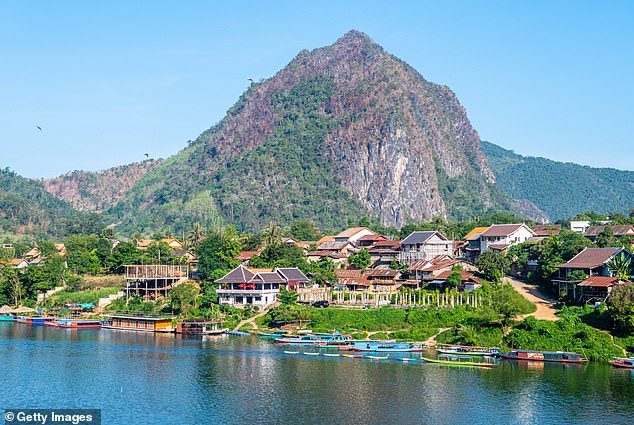Gliding gently down the wide Mekong River, we pass villages of bamboo houses and temples with golden leaf roofs that shimmer in the sun.
We watched water buffalos wallowing in the shallow waters and children splashing and waving at the passenger boats.
My friend and I arrived in northeastern Thailand the night before and in the morning crossed the ‘Friendship Bridge’ into Laos to board a boat on the Mekong River.
Passing through a tapestry of rural riverside life is a fitting introduction to a country where 80 percent of the population lives in the countryside.
Late afternoon brings us to Pakbeng village, a charming jumble of riverside guesthouses and hotels. On the other side is the Mekong Elephant Park.
Vibrant: During her tour of Laos, Annabel Venning stops in the quiet town of Nong Khiaw (pictured)

A temple in Luang Prabang, a UNESCO World Heritage city with French colonial influences. Annabel writes: ‘Ten years ago, Luang Prabang had 20 hotels. Now there are 200’
Laos was known as Lan Xang, “Land of a Million Elephants.” But now only 300 wild elephants remain, as development is destroying their jungle home.
Another 400 survive in captivity, brutally exploited in the logging industry or riding elephants. Ten die for every calf born.
However, there are sanctuaries like this one, where rescued elephants live free of chains and abuse. We spent a joyful afternoon watching four female elephants wander through the forest, screeching and rumbling happily. The highlight is the night bathing of the elephants. One is so excited that she slides on her knees off the sandbar and falls into the river.
Laos’ war-torn past belies the serene beauty of its landscapes
Back on the boat for the second day, the scenery becomes increasingly spectacular as the Mekong meanders past towering limestone karsts. It is the perfect entrance to Luang Prabang. The town holds UNESCO World Heritage status thanks to its fusion of traditional Lao wooden houses and cream colonnades from Laos’ French colonial era.
Sunlight shines on the roofs of the temples. Stalls sell freshly baked croissants or steaming bowls of pho. In the evening, a night market unfolds along Sisavangvong Road.
Ten years ago, Luang Prabang had 20 hotels. There are now 200, from the elegant Satri House to backpacker hostels. Our favorites are the elegant Apsara and the Apsara Rive Droite, on opposite banks of the Nam Khan River.
An hour’s taxi ride from Luang Prabang are Kuang Si Falls, a series of aquamarine waterfalls and pools where you can swim for hours, and in the opposite direction, Pak Ou Caves, filled with hundreds of Buddha statues. .

Annabel swims at Kuang Si Falls, pictured here, a series of aquamarine waterfalls and pools.

Annabel begins her journey in northeastern Thailand, where she crosses the ‘Friendship Bridge’ (above) into Laos.
To explore the less-traveled northeastern Laos countryside, you can easily rent a car and driver. The Apsara organizes ours through a cheerful guy named Sit with a penchant for 80s ballads.
A day’s journey takes us to the mysterious Plain of Jars: thousands of enormous stone jars, human height or more, scattered across 90 sites near the town of Phonsavan.
Rice wine or water tank, giant cups or funerary vessels? Nobody knows, but they are between 1,500 and 2,000 years old. It is one of the most spectacular archaeological sites in the world, but the area is also littered with unexploded ordnance.

The Plain of Jars: Thousands of huge stone jars, spread across 90 sites near the city of Phonsavan. Annabel says: ‘It is one of the most spectacular archaeological sites in the world’

Laos was known as the “Land of a Million Elephants” but now there are only 300 wild elephants left, Annabel reveals.
This area was the epicenter of the fighting in the Secret War, when the Vietnam conflict spread to Laos. The United States dropped more than 260 million bombs on the country, which remains the most bombed in the world. Many cluster munitions still remain unexploded on the ground.
Laos’ war-torn past belies the serene beauty of its landscapes, such as Nam-Et Phou Louey National Park. Here, we walked through green cathedrals of towering trees, stopping to eat sumptuous meals on banana leaf tablecloths.
We slept in ‘nests’: comfortable bamboo baskets suspended above the forest floor. At night we spotted a leopard cat and a sambar deer, during the day a giant squirrel.
On the way back to Luang Prabang, we stopped in the quiet town of Nong Khiaw and climbed a hill to watch the sunrise, then swam across the Nam Ou River.
On our last night, sadness descends: we never want our adventure in Laos to end.

